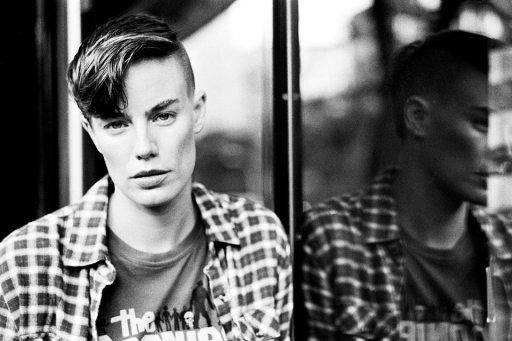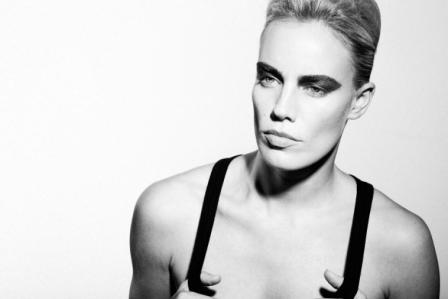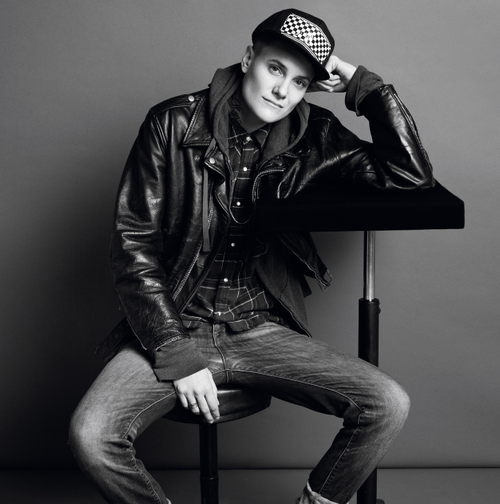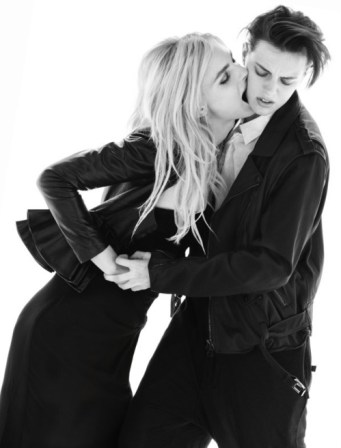Elliott Sailors is a professional model who has had a pretty successful career in the high fashion world, boasting time on the Ford board and appearances in Harper’s Bazaar, Cosmopolitan, Women’s Health, and this Icona Pop video, where she plays a judge at a drag ball.

About a year ago, Sailors got her hair cut short at her husband’s barbershop and started showing up at menswear casting calls. The look works well for her, and she was signed to Ford’s menswear roster. Last week, she received a flurry of press after a couple of “tell-all” interviews with the New York Post led to a bunch more interviews, articles, retrospective “transformation” photo galleries, and all the other stuff that tends to happen whenever someone in the public eye plays with gender even a little bit.

I’m not really concerned about why Sailors decided to work in menswear — I don’t know enough about the fashion world and its attendant pressures and prejudices to judge the merit or appropriateness of a pure career decision, and if the move is based in more personal gender-related feelings, then it’s absolutely not my place (or anyone else’s) to have an opinion. Her public explanations suggest a mix of both: she told the Post that she is “starting over to have a longer career,” because “men don’t need to look as young [as women],” but also said that although she has “never identified as a male,” she has a fluid interpretation of her own gender: “Who it is that I am is not limited to just being perceived as a female. Who it is that I am is inclusive also of what it is that is perceived as male. It’s a part of how I see myself.”
More interesting is how different news outlets privilege some explanations over others when telling her story — for the New York Post (and other mainstream outlets), “I did it for my career” is the lead argument, put front and center to legitimize the attendant “weirdness.” Meanwhile, queer and queer-savvy reporters apply the same hierarchy for different reasons — over at Slate‘s XX blog, Katy Waldman calls Sailors’s “stunt” “at best a canny career move… and at worst slightly insensitive to trans* people,” saying “there is no need to drape what is finally a perfectly pragmatic career decision in the drama of real-life gender reassignment.”

This is true and valid (although Waldman’s article is also problematic in a lot of ways, which I’ll get to later). We live in a world where actual trans* people are denied equal rights, situationally and institutionally misgendered, and murdered for who they are (even within the mainstream queer community, trans* issues almost uniformly take a back seat). The media is a huge part of the problem, constantly othering trans* people by disrespecting pronouns, inappropriately focusing on private aspects of transitions, clinging to outdated and pathologizing narratives, and generally fucking up what is actually not a very hard thing to understand. To see the same news outlet that constantly traffics in anti-trans* slurs call a gender-bending haircut “brave” and “hot” when a model gets it is really disgusting, and speaks to just how much you can “get away” with if you’re white and pretty and don’t push TOO hard. And Sailors herself seems, unfortunately, unaware of the rich history of public and artistic gender play outside the modeling world — she positions herself as someone who is starting conversations that have been going on for quite some time in other arenas (i.e. “I want to make something else available and possible for people”), and though she cites Andrej Pejic and Omahyra Mota as inspirations, she has so far not mentioned other clear vanguards, such as Mykki Blanco, iO Tillet Wright, and somewhere around 40% of all metropolitan coffeeshop employees.

At the same time, it’s hard to totally blame Sailors for the way people talk about her, or for the way she talks about herself. It’s easy to try—both are really appropriative and definitely problematic. First, and most frustratingly simple, is the way everyone insists on calling her a “male model.” Sailors is not a male model, she’s a menswear model. She is very clear about the fact that she continues to identify as a woman (a clarity that shouldn’t really be necessary; if cutting your hair, dressing in guy’s clothes, or anything short of identifying yourself as a guy made you a guy, my morning wardrobe choices would be a lot more fraught). And yet headline after headline makes this extremely basic mistake: a Google search for Sailors’s name yields “Gal finds success as male model“; “Female Model Turned Male Model” and “Lady Looks Like A Dude: Female Model Goes Male,” among others. Even a New York Magazine piece that is supposedly about Sailors addressing issues of trans* appropriation is titled “Female-to-male model Elliott Sailors Addresses Her Haters” (props to Allure, though, which got it consistently right).

The articles themselves are peppered with similar mischaracterizations, often right alongside the garden-variety female masculinity policing that we’ve come to expect (“She says her husband, Adam Santos-Coy, is supportive — although she was a jaw-dropping blonde when he married her”). And Elliott herself occasionally uses reductive language (“When I’m in an elevator, I notice that they let all of the girls go first — like the real girls”). Most of the articles also traffic in over-the-top statements of finality (“she would have to get her long hair cut off for good,” — it does grow back, Daily Mail) and conflate gender and sexuality like woah, whether explicitly (“Her movement into the male realm, she claims, is solely career-based rather than sexuality” – The Daily Beast) or implicitly, by emphasizing the fact that Sailors has a husband and that he’s cool with everything.
What’s at once the most heartening AND the most troubling about all this is that when Sailors is given the opportunity to speak freely and at length, she (besides the aforementioned slip-ups) doesn’t make these mistakes. In fact, she says consistently smart, aware, and interesting things about her own decisions and identity. In a video discussion on HuffPost Live, she talks about how she wants her choices to inspire people “to be free to express yourself in all of who you are—that you’re not limited to what you were at any point in time, that it’s possible always to continue to transform, and to find new forms of self-expression so long as they are authentic to you.” That’s a far cry from the “I cut my hair off forever and my skin is now grafted to this blazer” plotline that everyone else seems so eager to ascribe to her. She reiterates this in an interview with The Hairpin, saying that “who you are can be expansive; it can include many things. That’s what fashion is also about.” In the same interview, she elaborates on the new space she’s trying to create: “I’m not trying to be a man. But [in the modeling world], there’s menswear and womenswear. There isn’t an option for androgyny. I think that it’s totally possible that it will start happening… there will be something in between… it’s true that there are a number of places in between male and female.”

What cool things to say! It literally put a smile on my face, reading those things. As a genderqueer person who is keenly aware of the sheer magnitude of the number of in-between places she’s talking about, and who struggles to find public figures who play with gender and don’t solidly align themselves with terms like “boi” or “butch” or “stud,” I’m also really cognizant of how few people take the time to say them. And in a world where alternative gender identity is constantly and instinctively linked to alternative sexuality, it’s especially cool to hear an avowedly straight woman talk about how a masculine presentation is “sort of just more me.” And yet no one pulls those quotes.
Even queer and queer-culture-savvy writers are fucking this up. After accusing Sailors of appropriating trans* experiences—still a fair criticism, though again, I’d blame the news more than the subject—Waldman goes for a weird groin-kick, saying,”My colleagues at Outward were also unimpressed—and not just because more than one of them thought the shorn Sailors still reads as female.” If you think about Sailors as someone who is keeping her cis privilege while cashing in on trans* stories, the cattiness radiating from this statement makes some sense. But if you think of her in the way she describes herself—as genderfluid or androgynous, even though she lacks the exact vocabulary queer people generally use to talk about these things—this is straight-up gender policing, and it’s uncalled for, rude, and erasing.

We’ve seen this before—earlier this year, Casey Legler made headlines (a lot of similarly incorrect and essentializing headlines, as a matter of fact) when Ford hired her for their menswear board. Legler didn’t go the New York Post route, and mostly got coverage in fashion- or queer-focused outlets, including this one. Perhaps because of this, she was slightly more successful in getting quoted talking about this in-between, or even outside, space:
“I understand signifiers. We’re social creatures and we have a physical language of communicating with each other. But it would be a really beautiful thing if we could all just wear what we wanted, without it meaning something… it would be a lovely place if we didn’t necessarily judge or jump to conclusions because someone wants to wear a dress or because someone wants to wear pants.”
(In a video interview with Time, Legler repeatedly describes herself as a “male model” but qualifies it with “that’s such a weird thing to say, because I’m a woman, you know?”). Erika Linder, who does both womenswear and menswear shoots, has gotten even less attention, maybe because her fluid presentation is too confusing for journalists to properly cover. But in one interview I found, she spoke about how her style changes: “One day it can be very feminine and the other day it can be really masculine. I don’t want it to be just [one way or the other]. I want to play with both as much as possible and keep a balance between them.”

All of these models clearly and vocally identify outside of the gender binary. They are referred to with gendered language and stuffed into cookie-cutter “trans*” narratives — which, as Olivia has pointed out, don’t even apply to many people who do identify as trans* — not because this language and these stories actually describe them, but because our culture and our media don’t have the tools to deal with anything else. In a society obsessed with categorization — are you gay or straight? black or white? a girl or a boy? — even people who are explicitly trying to make some space in the middle, like Sailors or Legler, are shunted to one extreme or the other. It’s erasing, problematic, and sad, and it’s not Sailors’s fault. But until there’s room for people like her, the way she’s talked about — within and outside of the queer community — will be part of the problem.







